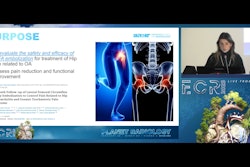
Arterial catheter embolization is an interventional radiology procedure that requires detailed documentation of the steps performed by the physician to maximize coding and reimbursement. The procedure places medications, embolic agents, or a radiopharmaceutical into a blood vessel to prevent abnormal bleeding, close off vessels, eliminate abnormal connections between arteries and veins, or to treat aneurysms or tumors.
Common embolization procedures include treatment of uterine fibroids or destruction of liver tumors using y-90 radioembolization.
Three current procedural terminology (CPT) codes describe these procedures, as shown in the table below.
| Vascular embolization or occlusion, inclusive of all radiological supervision and interpretation, intraprocedural roadmapping, and imaging guidance necessary to complete the intervention; | |
| 37242 | Arterial, other than hemorrhage or tumor (e.g., congenital or acquired arterial malformations, arteriovenous malformations, arteriovenous fistulas, aneurysms, pseudoaneurysms). |
| 37243 | Arterial, for tumors, organ ischemia, or infarction. |
| 37244 | For arterial or venous hemorrhage or lymphatic extravasation. |
Use of these codes is based on the abnormality being treated. They exclude embolization of the head, neck, or central nervous system (CNS). The embolization codes include the following steps, which should be documented but not coded separately:
- Direct vascular access (nonselective catheterization)
- Stent placement provided as support for embolization
- Guidance imaging and postembolization angiography
- Intraprocedural cone-beam CT with 3D reconstruction
- Multiple abnormalities in a single organ; For example, multiple tumors or aneurysms in a single kidney
Selective catheter placement, and any associated diagnostic imaging that is not bundled, is also documented and coded separately. When embolization is performed in multiple operative fields they are reported and coded separately, but with an appropriate modifier such as -59 (-XS for Medicare billing), which is used to identify procedures that are not normally reported together but are appropriate under the circumstances.
Arterial vascular embolization, other than for hemorrhage or tumor (37242)
Common procedures that use this code include the following:
- Arterial abnormalities such as arteriovenous malformations (AVM), aneurysms, pseudoaneurysms (nonbleeding), and AV fistulae
- Proximal nontarget vessel embolization (usually with coils) to prevent reflux embolization during the subsequent intended therapeutic embolization (e.g., yttrium-90 or transarterial chemoembolization (TACE) for hepatic tumor embolization)
- Genicular artery embolization (GAE) for treatment of painful osteoarthritis of the knee joint
- Bilateral uterine artery embolization immediately prior to a C-section or hysterectomy due to placenta accreta or placenta percreta and there is high risk for hemorrhage during surgery.
- Preoperative fracture fixation
Here are some usage tips:
- During diagnostic pelvic angiography and placement of bilateral arterial occlusion balloons that may be inflated to prevent pelvic hemorrhage, 37242 can be used once with modifier -52 (reduced services) along with 75736-50 (bilateral pelvic angiogram) and the appropriate catheter placement codes. Be sure that the diagnostic angiogram is medically necessary and properly documented with findings.
- If catheters are placed and the balloons are not inflated, then only report the catheter placements and the diagnostic imaging procedure.
- If permanent embolization becomes necessary, then 37242 is used without modifier -52.
- 37242 can be used when nontarget vessel embolization of an inferior mesenteric artery (IMA), internal iliac, or accessory renal is reported at the same session as an endovascular aneurysm repair (EVAR) or iliac aneurysm endograft repair.
Arterial vascular embolization for tumors, organ ischemia, or infarction (37243)
Common procedures that use this code include the following:
- Renal infarction for severe proteinuria
- Benign prostatic hypertrophy (BPH)
- Hepatic or osseous metastasis
- Renal cell carcinoma
- Uterine fibroids
- Benign or malignant vascular neoplasms/tumors
- Selective portal vein embolization pre-operatively to shrink a lobe of the liver that contains a tumor
- Splenic hypertrophy
- Direct needle access into head and neck tumors (e.g., carotid body tumor, glomus tumor)
Here are some usage tips:
- This code is used only once per surgical site.
- Nonselective access is bundled and not separately billable.
- Do not use 37243 for injection of macroaggregated albumin (MAA) in treatment planning. Rather, use 77290 (therapeutic radiology simulation, complex) for this purpose.
Vascular embolization for arterial or venous hemorrhage or lymphatic extravasation (37244)
Common procedures that use this code include the following:
- Postoperative hemorrhage (e.g., after knee replacement)
- Active esophageal hemorrhage
- Bronchial bleeding
- Gastrointestinal bleeding
- Postpartum hemorrhage
- Post-biopsy bleeding
- Postoperative bleeding (including into a joint)
- Trauma
- Thoracic duct leak
- Bleeding pseudoaneurysms
Here are some usage tips:
- When temporary balloon inflation is performed during a high-risk surgical procedure to control or treat an active hemorrhage, use 37244 with modifier -52.
Embolization or stent code?
It is sometimes difficult to determine whether to use embolization codes versus stenting codes, so we offer these guidelines:
- Use 37242 when a stent is used as a lattice to facilitate a peripheral or visceral embolization procedure (e.g., wide-mouthed aneurysm).
- Use the appropriate stent code (37238 or 37236, respectively) instead of an embolization code when a covered stent is the sole treatment (e.g., stent for venous rupture, covered stent for gunshot wound to subclavian artery).
- When both coils and a stent are placed to embolize a single site, code the appropriate embolization code rather than a stent code.
- When endograft placement is done for a vessel abnormality, and coils are placed in a vessel covered by the endograft, both the endograft placement code and the nontarget vessel embolization (37242) are reported.
Conclusion
As with all procedures, but especially with interventional radiology, it is critical to successful coding, billing, and practice reimbursement that the operative report be as detailed as possible. Although some steps might not be billable due to bundling provisions, the documentation must include them to be complete and to give your coding team the opportunity to optimize your reimbursement.
Erin Stephens is senior client manager, education at Healthcare Administrative Partners.
The comments and observations expressed are those of the author and do not necessarily reflect the opinions of AuntMinnie.com.



















